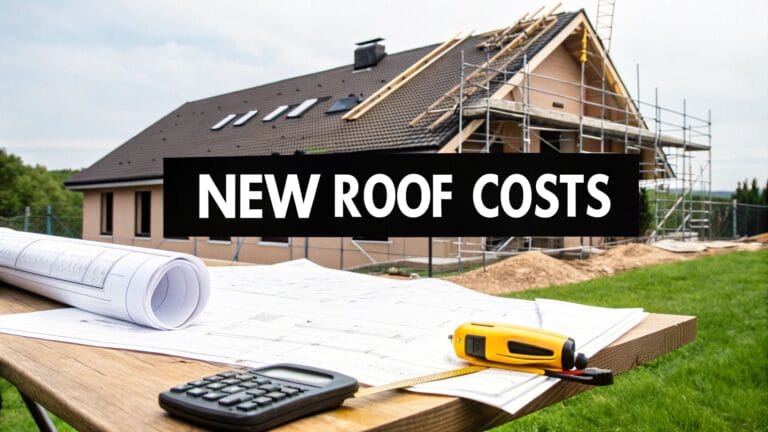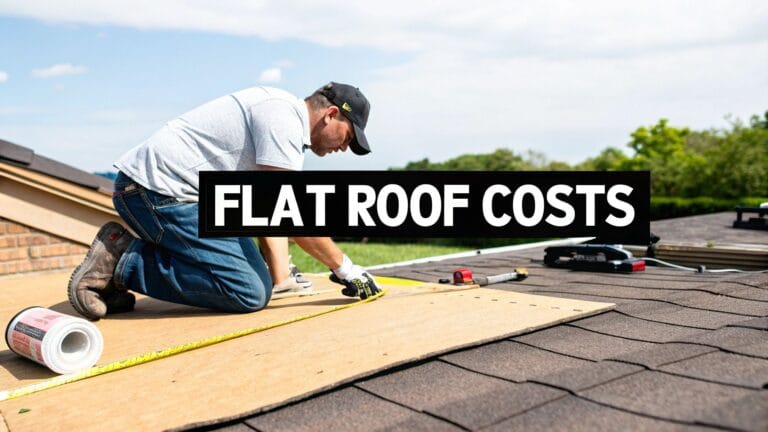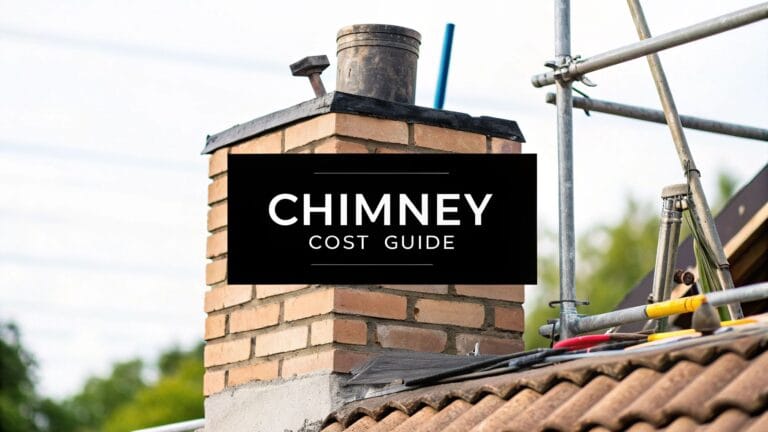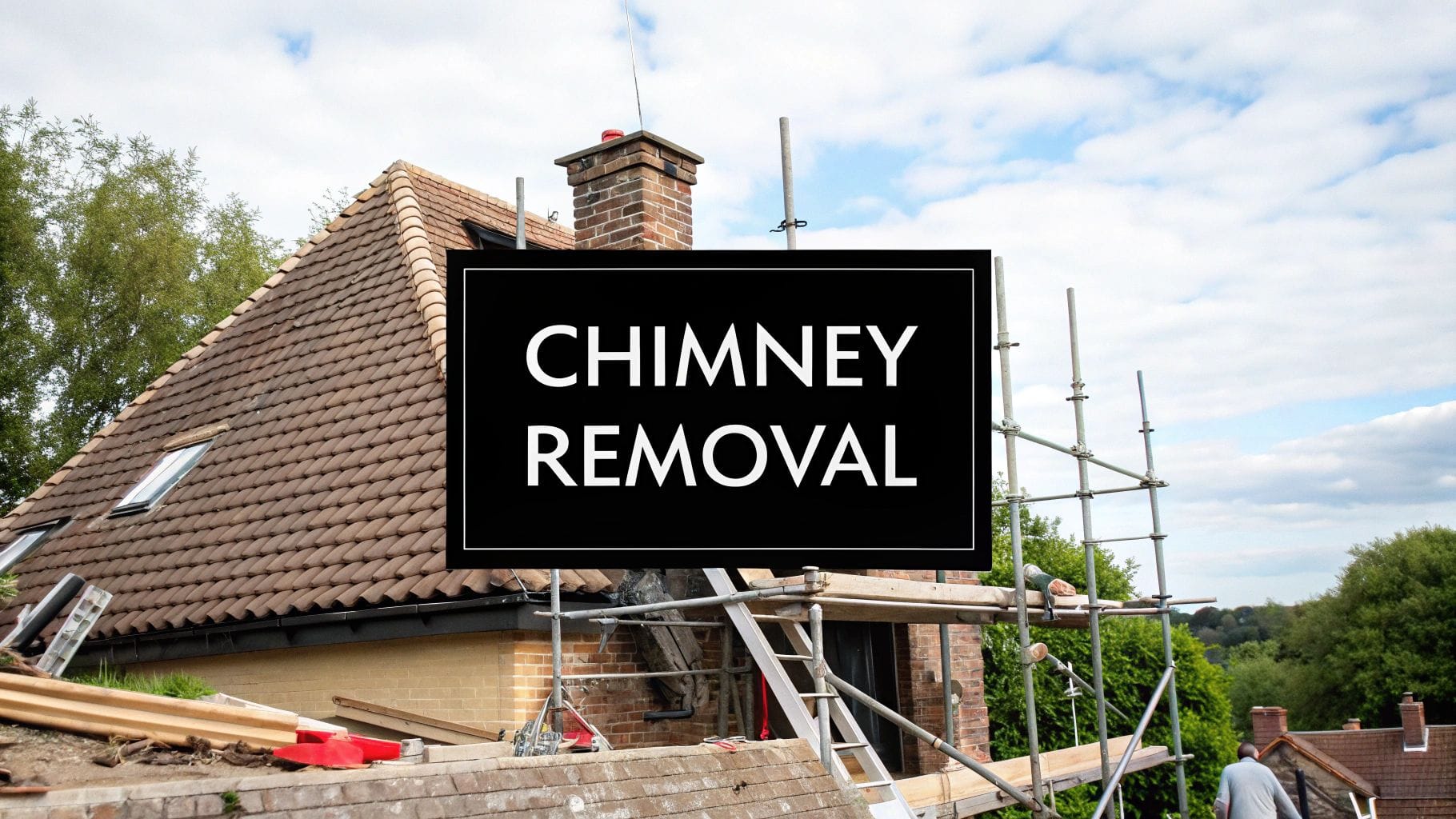
Removing Chimney Cost: The UK Guide to Budgeting & Savings
Learn about removing chimney cost in the UK. Get accurate estimates, expert tips, and a breakdown to plan your chimney removal effectively.
Thinking about getting rid of an old chimney? It's a popular home improvement project, but one that comes with a pretty broad price tag. In the UK, you can generally expect the cost of removing a chimney to fall somewhere between £1,200 and £3,500.
Where your project lands in that range really depends on the scale of the job. Are you just taking out the chimney breast in one room, or is the entire chimney stack, from the roof down, coming out? The answer to that question, along with the need for new structural supports and even your postcode, will shape the final bill.
Your Quick Guide to UK Chimney Removal Costs
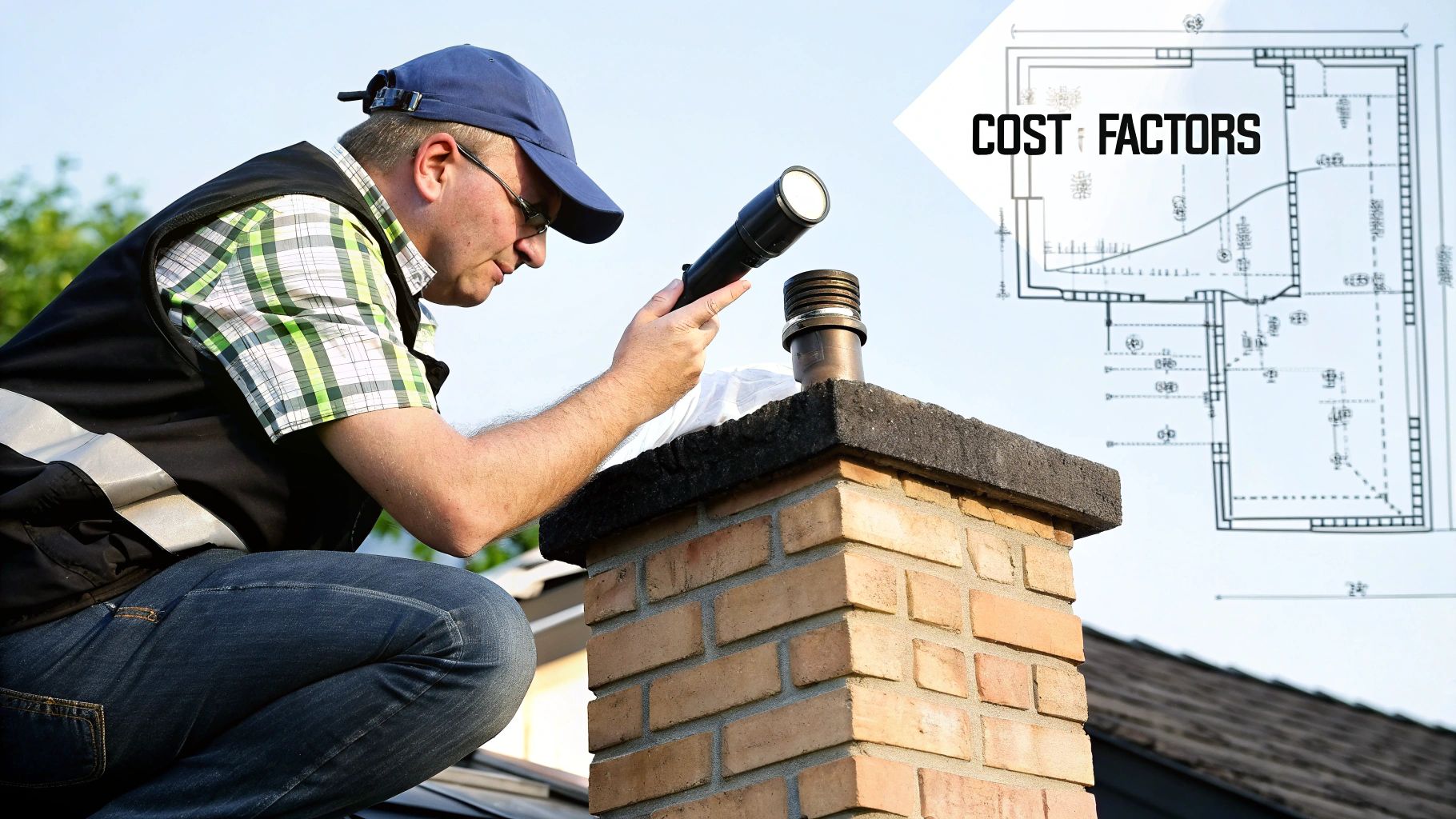
Deciding to remove a chimney is rarely just about looks. It's a major structural undertaking, often prompted by a desire to gain precious floor space, put a stop to chilly draughts, or address concerns about a deteriorating chimney stack. Before you start rearranging furniture in your mind, it’s crucial to get a handle on what the investment will look like.
The cost to remove a chimney isn't a one-size-fits-all figure. A simple job, like taking out a ground-floor chimney breast in an easily accessible house, will naturally be at the lower end of the scale. On the other hand, removing the entire stack from a terraced property, which often involves complex structural work and scaffolding, will push the price towards the upper limit.
At Evershield Roofing, we pride ourselves on providing transparent, detailed quotes. We break down the costs for labour, steel supports (like an RSJ beam), waste disposal, and "making good"—patching up the walls, floor, and roof—so you know exactly where your money is going.
A Financial Starting Point
So, what should you budget? The table below gives a quick overview of what you can expect for different types of chimney removal jobs we handle across Buckinghamshire and the surrounding areas.
Estimated Chimney Removal Costs at a Glance
| Type of Removal | Estimated Cost Range | Average Timeframe |
|---|---|---|
| Single-storey chimney breast removal | £1,200 – £1,800 | 1 – 2 days |
| Two-storey chimney breast removal | £2,000 – £2,800 | 2 – 3 days |
| Full chimney stack and breast removal | £2,500 – £3,500+ | 3 – 5 days |
These figures give you a solid idea of what to expect, helping you plan your project with confidence. Remember, the goal is not just to get the job done cheaply but to ensure your home remains structurally sound.
To give you a clearer picture, removing just the internal chimney breast will likely set you back between £1,200 and £3,500, with a common average hovering around £2,500. A project like this can take anywhere from a single day to four days, all depending on the complexity.
When you're looking at quotes from any company, make sure they break down the costs for labour, all the necessary materials, and the restoration work needed to maintain your home’s structural integrity. For further research on general budgeting, you can find helpful advice on planning your chimney removal budget from resources like MyJobQuote.co.uk.
This overview should give you a realistic baseline. Knowing these numbers helps you work out if the project is a good fit for your budget before you start seeking detailed quotes from professionals like us at Evershield Roofing.
Decoding Your Chimney Removal Quote
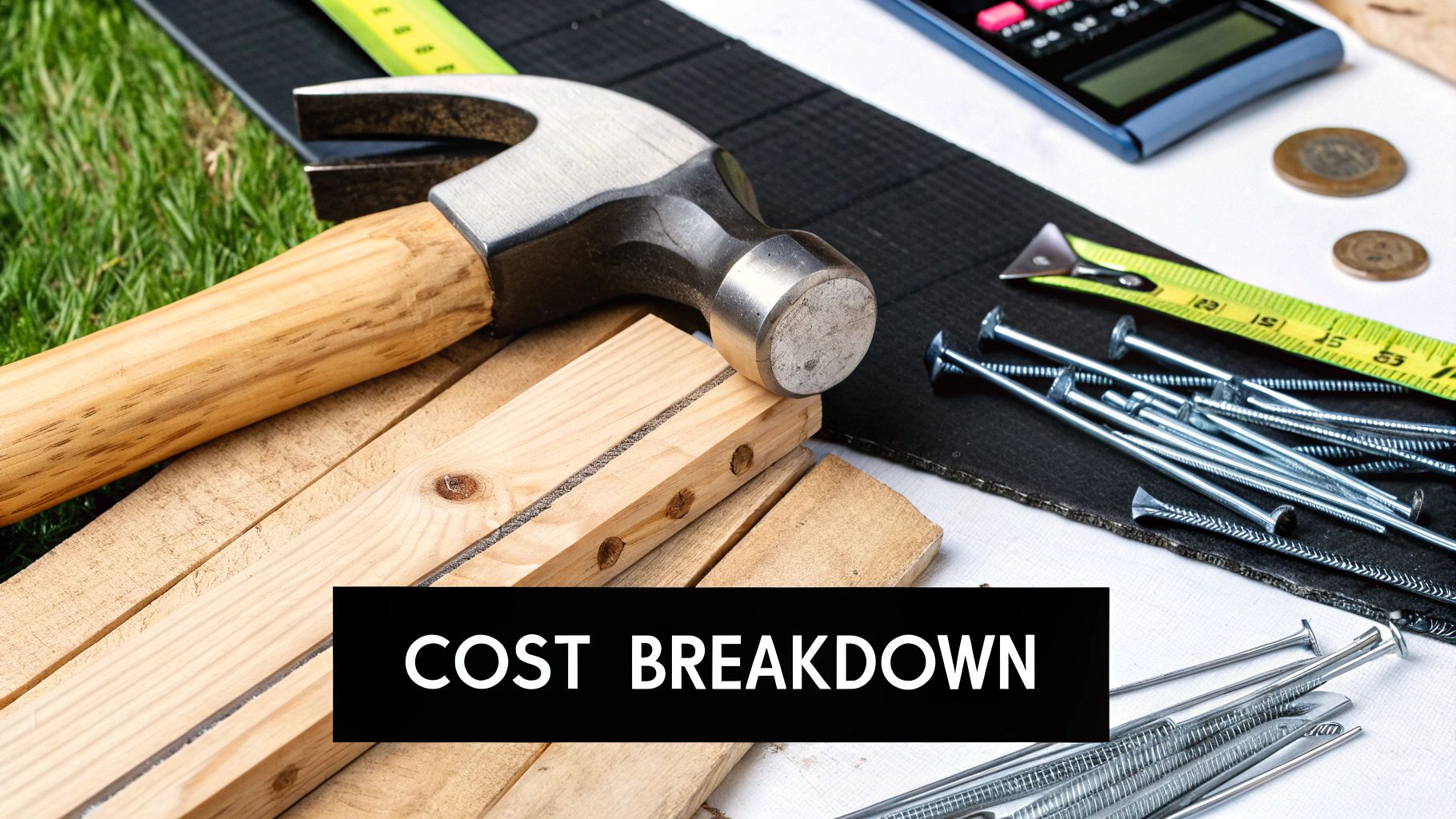
It can be baffling to see one quote for chimney removal land at £1,500, while another hits closer to £4,000. This huge difference rarely boils down to a builder's day rate. Instead, it’s a reflection of the specific challenges and unique details of your property. Getting to grips with these variables is the key to comparing quotes properly and avoiding nasty surprises down the line.
Think of it like getting your car serviced. A simple oil change is one price, but if the mechanic finds the brake system is shot, the bill will obviously climb. The same logic applies to the cost of removing a chimney; the initial figure is just the starting point.
The final invoice is shaped by a handful of crucial factors that any good builder will assess during their initial visit. At Evershield Roofing, we believe in being upfront, which is why we always provide a detailed breakdown explaining every single part of the job.
Key Factors That Influence Your Quote
Where the chimney is located is one of the biggest cost drivers. A chimney on an external wall is usually simpler to take down than one right in the middle of your home, which often means more complex structural work.
Another massive consideration is whether the chimney is part of a load-bearing wall. If it is, removing it becomes a far more delicate and serious structural job. This requires precise calculations from a structural engineer and the installation of heavy-duty steel beams (RSJs) to carry the weight of the floors and roof above. This is absolutely not a corner you can afford to cut.
The complexity of the structural supports is a primary reason for big cost differences between what might seem like similar jobs. A simple removal might need minimal support, but a project involving a load-bearing wall demands expert engineering, specialised skills, and pricier materials.
Beyond the Bricks and Mortar
Your quote also has to account for all the logistical, yet costly, bits and pieces that homeowners often forget. These practical necessities can easily add hundreds, if not thousands, of pounds to the final bill.
- Scaffolding: For any work done on the external chimney stack, scaffolding isn't just a good idea—it's a legal and safety must-have. How much you need and for how long will directly affect your budget.
- Waste Disposal: Taking out a chimney generates a huge amount of heavy rubble. A traditional brick chimney creates far more waste than a lighter, factory-made metal flue. Your quote must include the cost of hiring a skip to get rid of it all responsibly.
- Access and Making Good: Can builders get to your property easily, or are there challenges like a narrow street or no parking? On top of that, the quote should cover "making good"—the costs to patch the roof, plaster walls, and repair floors where the chimney used to be. Keeping the roof in top shape is crucial, and our guide on roofing maintenance tips offers some great advice on this.
Partial vs. Full Removal: Which Is Right for You?
One of the biggest decisions you'll make is whether to remove just the internal chimney breast or take the whole thing down, from the roof to the ground floor. This choice will have a major impact on the initial removing chimney cost, but it also affects your home's structural integrity and future maintenance needs. Really, it boils down to a classic trade-off: short-term savings versus long-term peace of mind.
A partial removal, where you only take out the chimney breast inside your rooms, is definitely the cheaper option to start with. It's a popular choice because it immediately gives you back precious floor space. The catch? The chimney stack left on the roof is now floating without its original support. It has to be propped up with heavy-duty steel beams (RSJs) and gallows brackets, and that unsupported stack will still need looking after and remains a weak spot for weather damage.
On the other hand, a full removal is a much bigger job and, naturally, costs more. This involves dismantling everything – the internal breast and the external stack – and then patching up the roof. While it’s a bigger hit to the wallet upfront, it completely removes any future chimney maintenance headaches and structural worries. For many homeowners in the UK, this is the ultimate "fit and forget" solution.
Making the Right Choice for Your Home
Let’s put this into a real-world context. Picture a typical 1930s semi in Buckinghamshire. You’re desperate for more space in the dining room and getting rid of the bulky chimney breast seems like the perfect answer. A partial removal looks tempting because it’s cheaper. Our team at Evershield Roofing could certainly do the job, putting in the right supports to make the remaining stack safe.
Fast forward a few years. You start noticing damp patches appearing on the ceiling. The old stack, now cold and exposed to the full force of the British weather without the warmth from a fire, has started to deteriorate and let in water. Suddenly, you're facing bills for scaffolding and chimney repairs – costs you would have completely dodged with a full removal from the start. It’s a very common story that perfectly illustrates the dilemma.
A partial removal solves the immediate problem of space but can leave you with a ticking time bomb on your roof. A full removal deals with the root cause, giving you a permanent solution that protects your property for good.
This visual guide can help simplify the decision for your own chimney removal project.
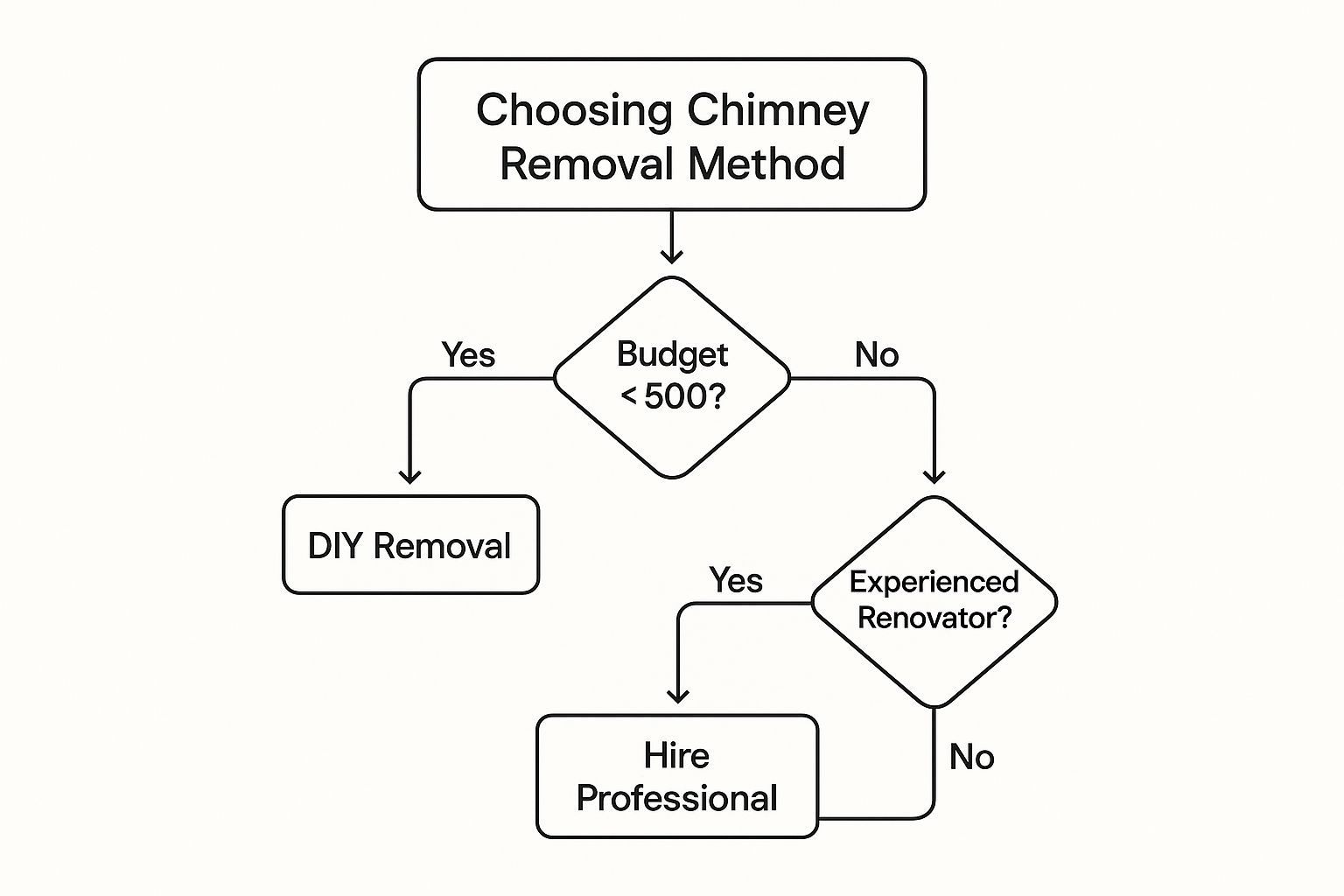
As the infographic suggests, your budget and confidence level often steer you towards either a professional job or a DIY approach, which is a whole other consideration.
Key Pros and Cons to Consider
To help you decide, our team at Evershield Roofing always lays out the pros and cons of each option side-by-side.
- Partial Removal (Pros): The initial cost is lower, and the work is completed much faster. You get that extra indoor space straight away without the disruption and expense of major roofing work.
- Partial Removal (Cons): You’ll need costly structural supports. More importantly, you're left with an external stack that requires ongoing maintenance and is a prime candidate for future leaks.
- Full Removal (Pros): This is a permanent fix. It wipes out all future chimney maintenance costs and structural risks. It can even make your home more energy-efficient by closing a major channel for heat loss.
- Full Removal (Cons): The upfront cost is significantly higher. It’s also a more disruptive project that involves major roofing work to tile over the hole left behind.
How Your UK Location Impacts Removal Costs

It’ll come as no surprise that just like the price of a pint, the cost to remove a chimney stack can change dramatically depending on your postcode. A job in a quiet Buckinghamshire village is going to be priced very differently from the exact same work on a terraced house in central London.
This isn't just a small variation, either. Where you live can have a huge impact on the quotes you get, and it’s about more than a simple North-South divide. Of course, labour rates are generally higher in the South East, but it's the on-the-ground logistics and local rules that really shape the final price. Knowing what these are will give you a much more realistic budget for your project.
Here at Evershield Roofing, we see this every day. Working across Buckinghamshire and the surrounding counties means we have to account for these local quirks in every single quote to give you a fair and accurate price for your specific home.
Why London and the South East Cost More
If you’re based in London or the South East, prepare yourself for higher quotes. It’s not because builders are trying to pull a fast one; it’s a genuine reflection of the unique challenges that come with working in a crowded, complex urban area.
In these regions, chimney stack removal costs are pushed up by everything from stricter rules to the simple headache of getting around. A basic stack removal might start at around £1,500, but for more complicated jobs, it’s not unusual to see prices climb past £4,000. This often depends on things like needing extra structural supports, the extent of interior and exterior repairs, and the specific fees your local council charges for permits.
To get a truly accurate estimate in these built-up areas, it’s always a good idea to have an accredited surveyor carry out a detailed assessment. You can learn more about the cost factors in these complex environments to see the full picture. It really shows why getting a bespoke quote from a local specialist who knows the patch, like Evershield Roofing, is so important.
Key Regional Cost Drivers
So, what are the specific things that cause these price differences? It really boils down to a few key factors. If you understand these, you'll be in a much better position to weigh up the quotes you receive.
- Labour Rates: It’s a fact of life that tradespeople in London and the Home Counties have higher day rates. This isn't greed – it's to cover their own steeper living and business running costs.
- Logistical Hurdles: Simple things become expensive problems in a city. Getting parking permits for the van, a licence for a skip, and just navigating congested streets all adds time and money to the job.
- Scaffolding and Access: Putting up scaffolding on a narrow terraced street with no off-road parking is a world away from doing it in a spacious suburban cul-de-sac. The complexity and cost can rocket.
- Local Council Regulations: Some councils are much stricter than others, especially in historic or conservation areas, which are common in the South. This can mean more paperwork, more detailed plans, and higher fees paid to Building Control.
By keeping these local factors in mind, you’ll have a much clearer idea of what a fair price for your chimney removal should look like when the quotes start coming in.
Budgeting for Hidden Fees and Professional Services
The builder's quote for your chimney removal is a big piece of the puzzle, but it's rarely the full picture. The total removing chimney cost needs to include essential professional fees and administrative costs that often get forgotten until the last minute. These aren't just optional extras; they're absolutely critical for making sure the whole project is safe, legal, and properly signed off.
Think of it like this: your builder is the surgeon performing the operation. But you still need the anaesthetist and all the hospital paperwork to make sure everything goes off without a hitch. For a chimney removal, these crucial supporting roles are played by structural engineers and your local council’s Building Control department. They are a non-negotiable part of the process.
The Role of a Structural Engineer
You'll almost certainly need to hire a structural engineer unless you're just taking out a small, non-structural decorative flue. It’s their job to figure out the exact support needed to carry the load of whatever you’re leaving behind—whether that’s the upper floors, the roof, or the remaining chimney stack above.
The engineer provides detailed drawings and calculations for the steel beams (RSJs) or gallows brackets required. This isn't just a bit of guesswork; it's a vital safety calculation. Your builder will use these precise plans to order the right materials and install them correctly. Trying to do this without professional input is a massive gamble on your home's structural integrity.
At Evershield Roofing, we work with trusted structural engineers and can manage this part of the process for you. Their fee, typically a few hundred pounds, provides the blueprint that makes the entire project safe and compliant.
Navigating Building Control and Council Fees
Any structural change to your home, and that includes removing a chimney breast, falls under UK Building Regulations. This means you have to inform your local council’s Building Control department before any work kicks off, which involves submitting an application and paying a fee.
A council officer will then visit your property at key moments to inspect the work, paying close attention to the installation of the new structural supports. Their job is to check that everything meets the required safety standards. Once they're happy, they'll issue a completion certificate. This piece of paper is your official proof that the job was done legally and correctly—and you absolutely will need it if you ever decide to sell your home.
Here's a look at the kind of professional and administrative fees you should be budgeting for.
Typical Professional and Administrative Fees
| Service | Typical UK Cost | Why It's Necessary |
|---|---|---|
| Structural Engineer | £350 – £800+ | Provides essential calculations and drawings for new supports (RSJs). Ensures the remaining structure is safe. |
| Building Control Application | £200 – £500+ | The fee paid to your local council to register the work and arrange for inspections. It's a legal requirement. |
| Party Wall Surveyor | £900 – £1,500 per neighbour | Only needed if you share a wall and your neighbour doesn't consent to the work. This fee covers a legally binding agreement. |
| Asbestos Survey | £200 – £400 | A precautionary step if your home was built before 2000. Identifies if any asbestos-containing materials are present. |
These costs are just as important as the builder's labour and materials, so make sure they're included in your budget from the very beginning to avoid any nasty surprises.
The Party Wall Act Explained
If you live in a terraced or semi-detached house, there’s one more administrative layer to deal with: the Party Wall Act 1996. If the chimney you’re removing is on a shared "party wall," you are legally required to give your neighbours formal written notice before the work begins.
Should they not give their consent, you might need to appoint a party wall surveyor to draw up an agreement. This can add significant time and cost to your project. Ignoring this step can lead to messy legal disputes, so it’s something you need to factor in right from the start. Issues with party walls can sometimes snowball into bigger problems, and our guide on common roofing problems and their solutions can offer some helpful insights into related concerns.
Finding and Vetting the Right Professionals
When the structural integrity of your home is at stake, picking the right builder for a chimney removal is the most critical decision you'll make. This is absolutely not a job for a general handyman; it demands very specific experience. So, how do you find a professional you can trust to do the job safely, legally, and for a fair price?
Your first step is to gather a few detailed quotes. When you contact Evershield Roofing, we provide a clear proposal from a vetted local specialist, giving you a much clearer picture of the market rate. Be wary of vague, one-line estimates – that’s a massive red flag.
A proper quote should be a detailed document. It needs to clearly itemise every single cost: labour, all materials (right down to the specific steel supports), scaffolding hire, skip hire for waste disposal, and the cost of ‘making good’ all the affected areas like your roof, walls, and flooring. This level of transparency is our promise to you and your best defence against surprise costs.
Asking the Right Questions
Once you have a shortlist of builders, it’s time to do some digging. A confident, experienced professional will have no problem answering your questions. Don't feel shy about getting into the nitty-gritty; this is a serious job, and you need to be sure they’re up to the task.
Here’s a quick checklist of essential questions to run through with every potential builder:
- Experience: "Can you show me examples of similar chimney removal projects you've completed, preferably nearby in Buckinghamshire?"
- Insurance: "What level of public liability insurance do you carry, and could I see a copy of the certificate?"
- Building Control: "How do you manage the Building Regulations process? Will you be the one to liaise with the local council inspector?"
- Team: "Who will actually be working on my property? Are they your direct employees or subcontractors?"
- Timeline: "What's your estimated start date, and how long do you expect the whole project to take?"
Taking the time to ask these questions will give you the confidence you need to hire the right team. Remember, while a full removal gets rid of future structural headaches, any part of the chimney you leave behind will still need looking after. For more on keeping your chimney in top condition, take a look at our expert chimney repairs service.
Got Questions About Chimney Removal? We've Got Answers
Thinking about removing a chimney often brings up more questions than answers. It's a world filled with technical terms, regulations, and a few common myths. Let's clear the air and tackle some of the most frequent queries we hear from UK homeowners, so you can approach your project with confidence.
Do I Need Planning Permission to Remove a Chimney?
This is usually the first question on everyone's mind. For the most part, simply taking out an internal chimney breast doesn't require planning permission. The situation changes, however, when you're looking to remove the external stack from your roof. You'll likely need permission if your home is a listed building or sits within a conservation area.
A crucial point to remember: even if you don’t need planning permission, you will always need Building Regulations approval for the structural work. Before you lift a single tool, check with your local council. Our team at Evershield Roofing can guide you through this process.
What Are My Legal Duties to My Neighbours?
If your home is terraced or semi-detached, you'll need to get familiar with the Party Wall Act 1996. This act is there to protect both you and your neighbours when work affects a shared wall. You are legally required to give your neighbours formal written notice before the project starts, because removing your side of the chimney can have a real impact on their property.
Should they not give you their consent in writing, the next step is often hiring a party wall surveyor to draw up a formal agreement. It's a non-negotiable step to prevent future disputes, but be aware that it will add to your project's timeline and budget.
Can I Save Money by Doing It Myself?
It's tempting to think about going the DIY route to cut down on the removing chimney cost, but this is one job where we strongly advise against it. Removing a chimney isn't like putting up a shelf; it's a major structural alteration. The work demands precise calculations from a structural engineer to guarantee that whatever is left—be it the floors above or the remaining roof stack—is properly and safely supported.
Getting it wrong isn't just a minor mistake. It could lead to a catastrophic structural failure, risking immense damage to your property and, more importantly, your family's safety. Always bring in qualified professionals who can manage the job correctly and give you that all-important Building Regulations completion certificate.
When you're ready to get a clear, no-obligation quote from experienced professionals who understand the complexities of UK homes, Evershield Roofing is here to help. We ensure every project is completed safely and to the highest standard. Contact us today to discuss your project at https://www.evershieldroofing.co.uk.

